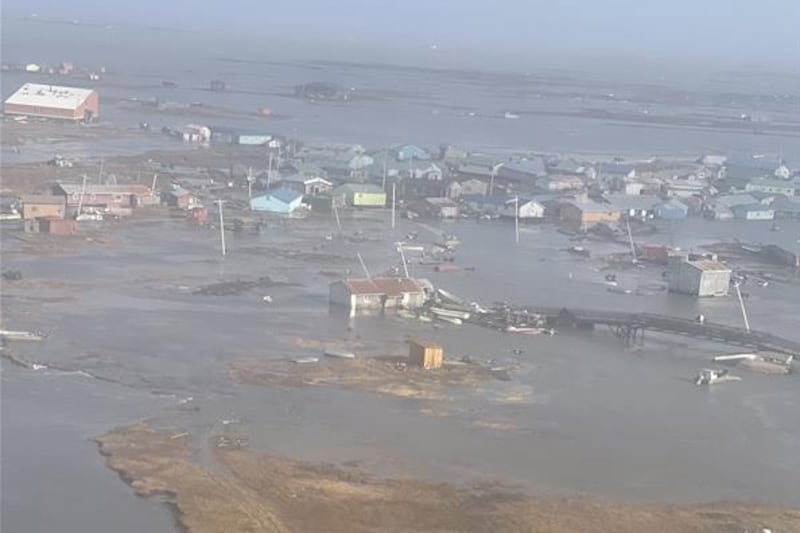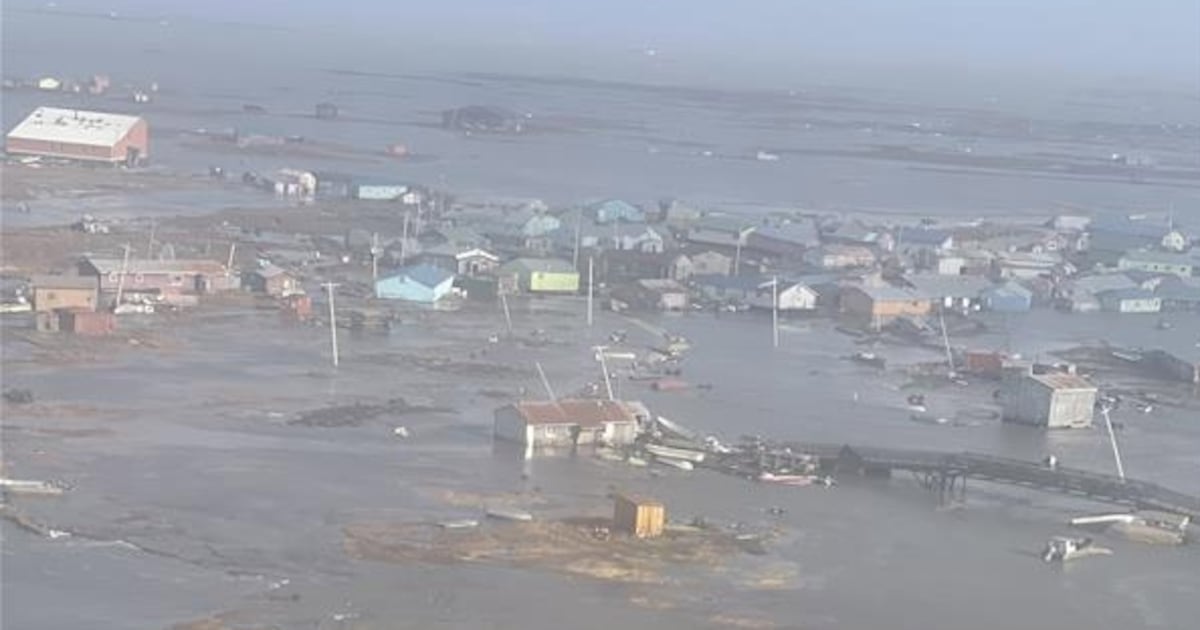 U.S. Coast Guard MH-60 Jayhawk helicopter aircrews conduct overflights of Kipnuk, Alaska, after coastal flooding impacted Western Alaska communities, Oct. 12, 2025. (U.S. Coast Guard photo courtesy of Air Station Kodiak)
U.S. Coast Guard MH-60 Jayhawk helicopter aircrews conduct overflights of Kipnuk, Alaska, after coastal flooding impacted Western Alaska communities, Oct. 12, 2025. (U.S. Coast Guard photo courtesy of Air Station Kodiak)
The Environmental Protection Agency under President Donald Trump on Thursday defended its decision earlier this year to rescind a $20 million grant meant to prevent coastal erosion in Kipnuk.
Kipnuk was one of the hardest-hit villages from the remnants of Typhoon Halong, which hit Western Alaska over the weekend.
Dozens of homes in Kipnuk washed away in a record-breaking storm surge, causing hundreds to evacuate and leaving the community wondering about its future.
The $20 million federal grant had been awarded to the village in December, from a program created under the administration of former President Joe Biden to mitigate the impacts of climate change.
But the Trump administration, targeting initiatives funded by the Inflation Reduction Act, canceled that grant in May, along with hundreds of millions of dollars in funding meant for climate change mitigation and renewable energy projects in Alaska.
In a statement, a spokesperson for the EPA appointed under Trump said that had the grant not been canceled, the money would have been wasted.
“To be brutally candid, due to the proactive cancellation of this grant, $20 million of hardworking U.S. tax dollars are currently sitting in the U.S. treasury instead of swept into the Kuskokwim River,” EPA press secretary Brigit Hirsch said.
In July, the Native Village of Kipnuk’s environmental director, Rayna Paul, wrote that without the erosion barrier that the grant was intended to fund, the village’s “homes, boardwalks, power lines and some hazardous materials could fall into the river.”
On Sunday, Kipnuk’s homes, boardwalks and power lines were inundated.
“Without this barrier, we may be forced to relocate our entire village,” Paul wrote in July.
The grant cancellation has drawn scrutiny in recent days as Kipnuk residents mourn the destruction in their community, including from the EPA staff who worked on reviewing Kipnuk’s grant application.
“EPA non-political staff has begged and pleaded with our political leadership and representatives to no avail,” wrote union president Lauren Boldrick, who represents many of the EPA employees in the Alaska region, in an opinion piece published Thursday. “None of you listened or cared, and now the consequences of your callousness are laid bare.”
The grant meant for Kipnuk likely would not have arrived early enough to prevent the damage caused by the storm, U.S. Sen. Lisa Murkowski said in a statement Tuesday. However, she said that the storm damage underscores the importance of such funding to prevent destruction from future storms.
“While this canceled grant likely wouldn’t have completed construction in time to mitigate the flooding damage we’re seeing now, it underscores not only the urgent need for federal investment to make these communities more resilient, but also the importance of reducing the amount of bureaucracy and red tape small communities like Kipnuk must cut through,” Murkowski said.
“This administration prioritizes lowering costs — but minimizing the impacts of a disaster like this before it occurs is far cheaper than rebuilding afterward, to say nothing of the toll these events take on people’s lives,” Murkowski added. “The best time to prepare our communities was 20 years ago; the next best time is now.”
Hirsch, with the EPA, said in her statement that “partisans on the left would apparently prefer to have seen those precious tax dollars washed away.”
After it canceled hundreds of millions of dollars in grant funding to Alaska, the EPA earlier this year awarded $140 million to the Denali Commission to support infrastructure projects in Alaska Native villages. Hirsch said that money is only available because the Kipnuk grant and others were canceled.
“EPA now has the resources available to ensure the money is spent appropriately and wisely,” she said.
Sally Russell Cox, who manages an Alaska Division of Community and Regional Affairs program meant to help Alaska Native villages plan for the effects of coastal erosion and other environmental hazards, said that accessing mitigation funding has been “consistently challenging.”
“Any termination of funding for these hazards reduces communities’ capacity to mitigate potential impacts,” Cox wrote in an email, responding to a question about the Trump administration’s decision to cancel numerous EPA grants.
Hirsch said the “EPA is in active coordination with Alaska to support emergency response efforts and we stand ready to work with all of Alaska to identify infrastructure projects, in addition to the critical support EPA proudly provides to Alaska communities.”
The federal government for decades has warned of the threats posed by coastal erosion in Alaska Native villages. But despite a series of reports and federal funding programs, many villages — like Kipnuk — remained unprepared for the storm that struck over the weekend, amid repeated shifts in federal and state priorities.
